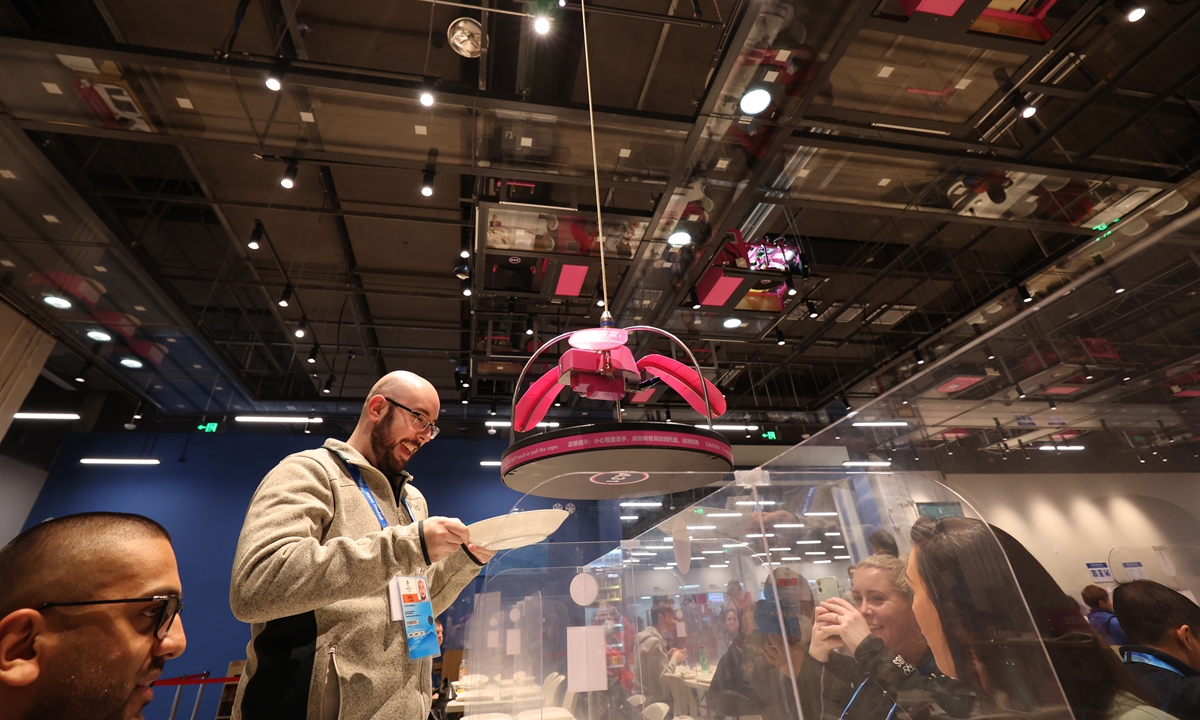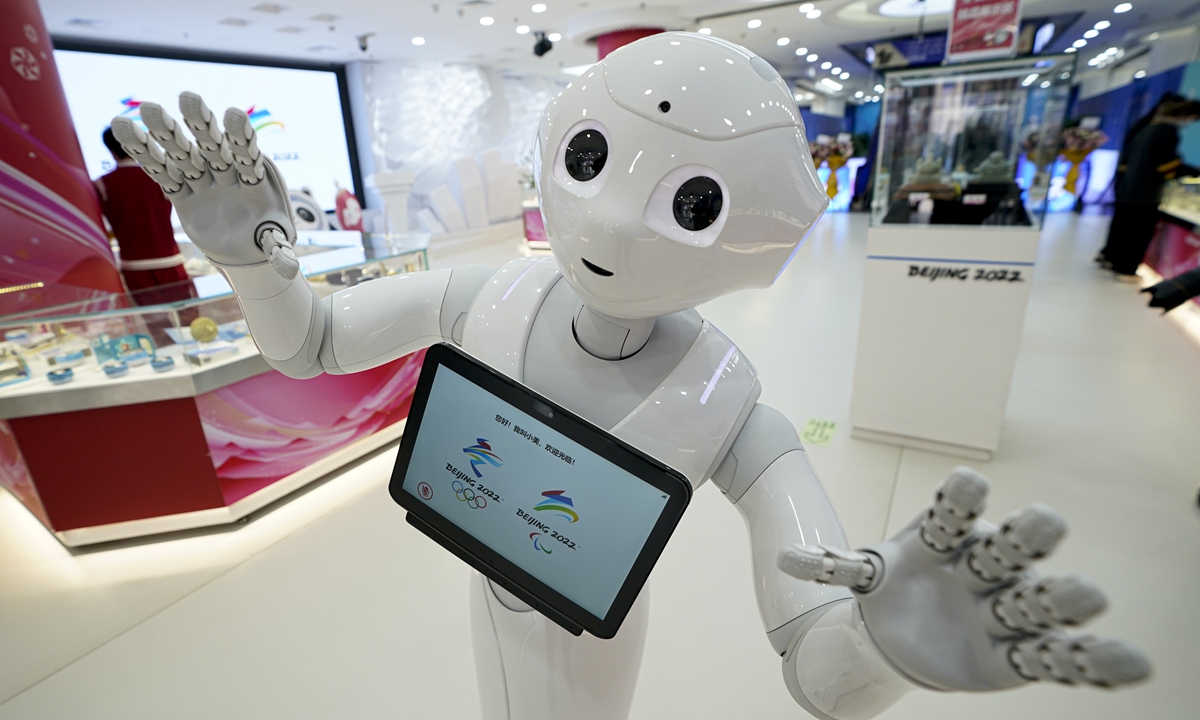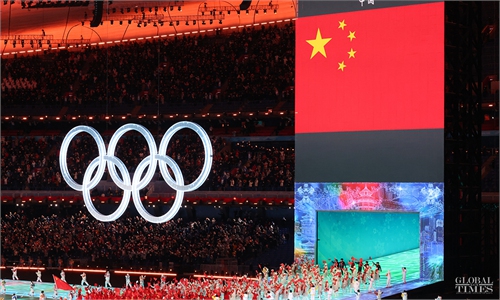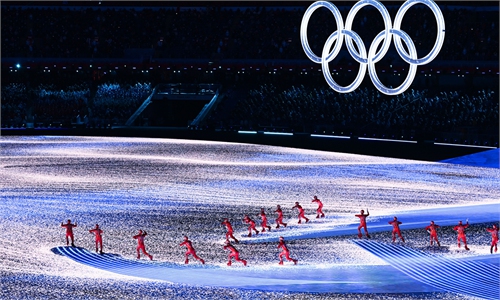A truly high-tech Winter Games:5G, AI, cloud, and more seen at Beijing’s sports gala
5G, AI, cloud, high-speed train, and more seen at Beijing’s sports gala

A canteen robot serves food at the Olympic Village on January 29, 2022 Photo: VCG
From unmanned broadcasting, 5G-wired high-speed trains, robot restaurants, zero-gravity beds to coronavirus prevention robots, the 2022 Winter Olympic Games in Beijing is not only a global sporting carnival while the pandemic still rages, but the event also turns out to be a concentrated display of latest high and new technologies.These dazzling technologies, some of which haven't been widely applied in our daily life, have received increased exposure through the Beijing Winter Games, creating more possibilities for international tech giants.
The one that has drew most attention is the smart bed technology in the athletes' village, which includes a "zero-G" mode that can help athletes improve blood circulation and accelerate recovery from a hard training course.
Athletes have already taken to social media to praise the beds, contrasting with last year's Summer Games in Tokyo when many athletes publicly complained about the small, cardboard beds they were provided with. "I have something incredible to share," said US athlete Summer Britcher in a TikTok video clip, in which she shows off and details the luxurious remote-controlled beds. In a follow-up video, Britcher was seen happily tucked in and said, "I'm in Zero-G mode now. It's phenomenal."
Indeed, to offer smart and convenient experiences for athletes and the media, as well as for the anti-pandemic needs, more than 200 types of technology, including 5G, AI, cloud, high-speed rail and new energy, have been tested and used across various aspects of the event, according to a report from domestic news site sciencenet.cn.

Photo:VCG
Tech for health
Coronavirus prevention and control represents one of the top priorities for the 2022 Beijing Winter Olympics, thus advanced technologies aiming to reduce in-person contact and improve COVID-19 test efficiency are becoming one of the top settings for the organizers.
For instance, the "underarm Band-Aid", a similar size to that of a mobile phone card, helps measure body temperature. The staff can simply apply the smart thermometer to their skin and the temperature data will be displayed in an app on their mobile phones.
This allows athletes and spectators to monitor the temperature of each staff member in real-time and it will alert automatically if the body temperature exceeds 37.3 degrees Celsius, according to a report from the People's Daily.
The dried blood spot (DBS) testing, a new technique for collecting biological samples, will also be used in the Games for the first time. It collects whole blood samples for storage and subsequent analysis. With the advantage of using only small blood volumes, convenience, reliability, and greater sample stability, DBS testing will be a powerful weapon in the fight against doping in the Games.
An advanced remote ultrasonic robot diagnosis system will be used in the closed-loop management area for patients treatment, enabling a "doctor-patient non-contact" diagnosis, according to a statement MGI, a Shenzhen-based producer of high throughput genome sequencing machine, sent to the Global Times.
The remote ultrasonic robot diagnosis system is divided into a doctor end and a patient end. During the Olympic Games, the patient end was deployed in the closed-loop clinic, and the sonographer could complete remote scanning and real-time consultation and communication outside the closed-loop area through the doctor-end profiling probe, according to the company.
The Games' competition venues are equipped with an aerosol coronavirus detection system, which can realize early warning and rapid detection, with detection sensitivity three times higher than traditional methods.
Robots are disinfecting sporting venues and providing hand sanitizer. And driverless electric vehicles will make deliveries between the closed-loop area and other areas to reduce person-to-person contact.
A peek into future
More than anti-pandemic use, the technologies that remain in their testing stage or waiting for public use have also shown their value - from training preparation to venue construction, technologies in clean energy - during the rare global event that comes amid pandemic, offering a glimpse of what life and the games would look like in the future.
For instance, the opening ceremony held in the National Stadium, also known as the Bird's Nest, has used the world's largest 3.5G bandwidth for the first time, and can achieve the ultimate speed experience of 1.5Gbps downlink and 500Mbps uplink, achieving the world's fastest 5G speed, China Unicom said in a statement it sent to the Global Times on Sunday.
The firm also helped build the 5G network on the Beijing-Zhangjiakou railway, the world's first smart high-speed rail fully covered by 5G.
When it comes to services, Beijing Winter Olympic Games have employed virtual humans as a means for broadcasting sign language. The first AI sign language anchor created by Baidu Smart Cloud was launched ahead of the Games' official opening. She has "real-life" skin, hair, and eyes, a friendly and natural image, and an elegant and unique temperament.
With AI capability, the anchor provides sign language services for hearing-impaired users, allowing them to quickly obtain event information.

An AI sign language anchor Photo: Courtesy of Baidu


